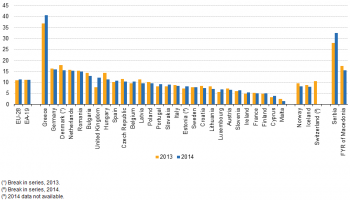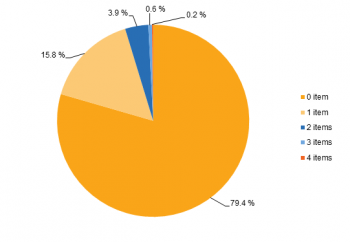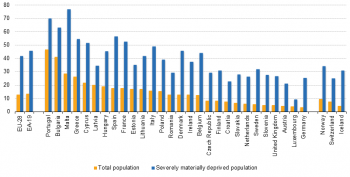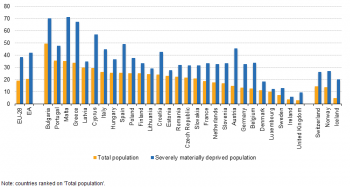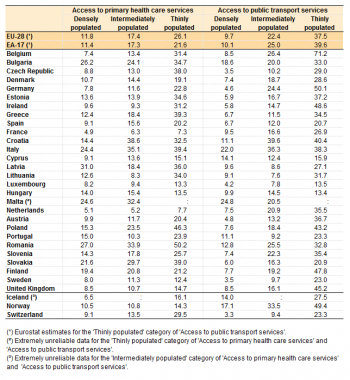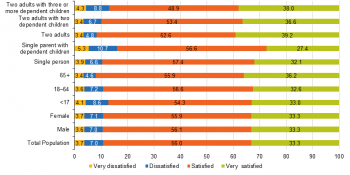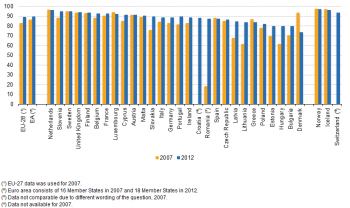Archive:Housing conditions
Data from March 2016
Planned update: March 2017
Most recent data: Further Eurostat information, Main tables and Database
This article analyses recent statistics on housing conditions in the European Union (EU). The cost and quality of housing is a key to living standards and well-being; shortage of adequate housing is a long-standing problem in most European countries. Over the past decade, worsening affordability, homelessness, social and housing polarisation and new forms of housing deprivation have been an increasing concern for public policy.

(% of population)
Source: Eurostat (ilc_lvho01)
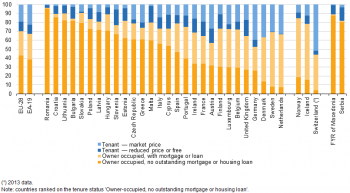
(% of population)
Source: Eurostat (ilc_lvho02)
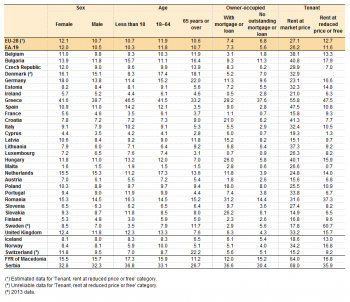
(% of specified population)
Source: Eurostat (ilc_lvho07a) and (ilc_lvho07c)
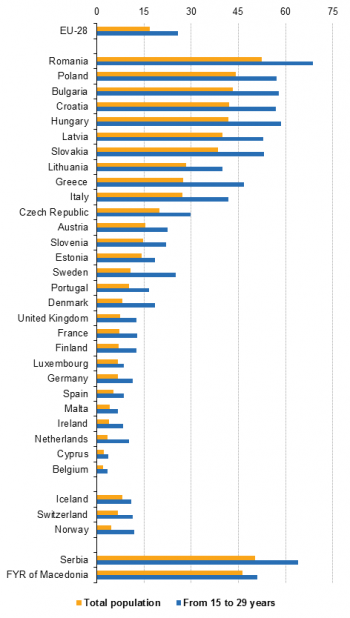
(% of specified population)
Source: Eurostat (ilc_lvho05a) and (ilc_lvho06)
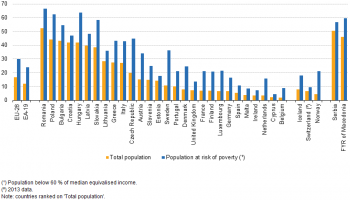
(% of specified population)
Source: Eurostat (ilc_lvho05a)

(m2)
Source: Eurostat 2012 ad-hoc module 'Housing Conditions' (ilc_hcmh01)

(% of specified population)
Source: Eurostat (ilc_mdho01), (ilc_mdho02), (ilc_mdho03) and (ilc_mdho04)

(% of specified population)
Source: Eurostat (ilc_mdho06a)

(% of specified population)
Source: Eurostat (ilc_mddw01), (ilc_mddw02) and (ilc_mddw03)
Main statistical findings
Type of dwelling and tenure status
In 2014, 39.7 % of the EU-28 population lived in flats and 59.6 % in houses (see Figure 1). The share of persons living in flats was highest among the EU Member States in Spain (66.6 %), Latvia (65.1 %) and Estonia (62.7 %). The share of people living in houses peaked in Ireland (92.8 %), the United Kingdom (84.7 %), Croatia (80.8 %) and Belgium (77.6 %); Norway also reported a high share of their population living in houses (82.0 %).
Over one quarter (27.1 %) of the EU-28 population lived in an owner-occupied home with mortgage or loan while almost half (42.9 %) of the population lived in an owner-occupied home with no outstanding mortgage or housing loan (see Figure 2). As such, just over seven out of every ten (70.0 %) persons in the EU-28 lived in owner-occupied dwellings, while 19.0 % were tenants with a market price rent, and 10.9 % tenants in reduced-rent or free accommodation.
More than half of the population in each EU Member State lived in owner-occupied dwellings in 2014; the share ranged from 52.4 % in Germany to 96.1 % in Romania. In Switzerland, people living in rented dwellings outweighed those living in owner-occupied dwellings (56.0 % of the population are tenants). In Sweden (61.3 %), the Netherlands (59.2 %) and Denmark (49.5 %) more than half of the population lived in owner-occupied dwellings with mortgage or loan; this was also the case in Norway (65.6 %) and Iceland (62.3 %).
The share of persons living in rented dwellings with a market price rent in 2014 was less than 10.0 % in 11 EU Member States. In Germany, Denmark, the Netherlands, Sweden and Austria more than one quarter of the population lived in rented dwellings with a market price rent; this share rose to slightly more than half (51.8 %) in Switzerland. The share of the population living in a dwelling with a reduced price rent or occupying a dwelling free of charge was less than 20.0 % in all EU Member States.
Housing affordability
In 2014, 11.4 % of the EU-28 population lived in households that spent more than 40 % of their disposable income on housing (see Figure 3). In Greece, Germany, Denmark, the Netherlands and Romania the housing cost overburden rate exceeded 14.0 %, while the lowest rates were reported by Cyprus (4.0 %) and Malta (1.6 %).
Between 2013 and 2014, the housing cost overburden rate in the EU-28 increased by 0.4 percentage points (pp). In total, 12 EU Member States reported increases for 2014, as compared with 2013, ranging from + 0.2 pp in Finland, to + 4.2 pp in the United Kingdom. Serbia also reported an increase in respective housing cost overburden rates for 2014, as compared with the previous year. In two EU Member States, namely France and Sweden, the rates remained stable. On the other hand, the largest decreases were reported in Hungary (– 2.9 pp), Denmark (– 2.3 pp) and Latvia (– 1.8 pp).
Housing affordability varies between different groups in society. Overall, women were found to be more vulnerable to housing cost overburden than men in most EU Member States, with the exception of Estonia and Spain (see Table 1). This trend was especially evident in Germany, where overburden rates were 4.2 pp higher for women than for men, as well as in the Czech Republic (3.0 pp), Latvia (2.2 pp) and Bulgaria (2.1 pp). Large differences were also reported in Switzerland (2.3 pp higher).
No clear trend was apparent in terms of a person’s age with regard to housing affordability; at EU-28 level the percentage of people whose housing costs exceeded 40 % of their equivalised disposable income in 2014 was 10.7 % for people under the age of 18, 11.9 % for people aged 18–65 and 10.6 % for people aged over 65.
However, the same cannot be said for all EU Member States. In 10 EU Member States the elderly suffered more than the younger age groups with regards to housing cost affordability with the greatest differences in the housing cost overburden rate between the 18–64 age group and the elderly (+ 65) in Germany, Bulgaria, and the Czech Republic (which reported differences of 6.8, 5.3 and 4.0 pp respectively) and also in Switzerland (which reported a difference of 13.5 pp). On the other hand, the largest difference for those EU Member States where the younger group (18–64) suffered more than the elderly (+ 65) were observed in Spain (8.6 pp) and Greece (8.3 pp).
The proportion of the population whose housing costs exceeded 40 % of their equivalised disposable income was higher for owners with a mortgage or loan than those owners that had no outstanding mortgage or housing loan, with the exceptions of Bulgaria, Denmark, Ireland, Greece, Luxembourg, Austria, Finland and Sweden. The same exception applied for the FYR of Macedonia. For tenants, higher overburden rates tended to apply to those tenants that pay their rent at the market price. The only exceptions here applied to Romania and Sweden; however data for Sweden should be treated with caution due to low reliability of the value for those renting at reduced price or free.
Housing quality — overcrowding
One major element of the quality of housing conditions is the availability of sufficient space in the dwelling. The indicator that has been invented to describe space problems is the overcrowding rate, which assesses the proportion of people living in an overcrowded dwelling, as defined by the number of rooms available to the household, the household’s size, as well as its members’ ages and family situation.
In 2014, while the EU-28 average rate of overcrowding was 16.9 % (see Figure 4), the highest rates of overcrowding were observed in Romania (52.3 %), Poland (44.2 %) and Bulgaria (43.3 %), and the lowest in the Netherlands (3.5 %), Cyprus (2.2 %) and Belgium (2.0 %).
Overall in the EU-28 (see Figure 5), the overcrowding rate was higher for those who were at risk of poverty compared with the total population.The largest differences in the overcrowding rates between the two groups were observed in Sweden (25.6 pp), the Czech Republic (24.8 pp), Hungary (21.9 pp) and Slovakia (19.6 pp). On the other hand, the smallest differences were observed in Ireland, Estonia and Cyprus (each having less than 4 pp).
Apart from the overcrowding rate, other gauges, such as the size of the dwelling, can also provide a representative picture of housing quality, in terms of the availability of sufficient useful space in the dwelling.
In 2012, the average size of the dwelling at EU-28 level was 95.9 m2. The average useful floor area of a dwelling varied in size from 44.6 m2 in Romania, 62.5 m2 in Latvia and 63.2 m2 in Lithuania, to 141.4 m2 in Cyprus (see Table 2).
Overall, the owners with a mortgage or loan lived in dwellings whose size was on average 119.7 m2, while owners with no outstanding mortgage or housing loan had on average less living space at their disposal (96.8 m2). Among homeowners, this pattern was evident in the majority of EU Member States, except for Spain, France, Italy, Luxembourg, the Netherlands and Romania. The same exception applied to Iceland.
On the other hand, Europeans living in rented dwellings had, on average, less useful floor area at their disposal compared to homeowners.
In the case of those living in dwellings with a market price rent reported an average size of 74.5 m2 for their dwelling, while those living in dwellings with a reduced price or free of charge reported an average size of 78.7 m2.
Dwellings rented at market price varied in size across EU Member States. In Estonia, Latvia, Lithuania, Hungary, Poland, Romania and Slovenia rented dwellings at market price were relatively small (less than 50 m2), while in Belgium, Spain, Cyprus and Luxembourg (as well as Iceland and Switzerland) the usable floor in dwellings rented at market price exceeded 80 m2, peaking at 91.9 m2 in Cyprus. Tenants living in dwellings with a reduced price or free of charge had relatively more usable floor space at their disposal and exceeded 100 m2 in Denmark, Cyprus, Luxembourg, the Netherlands and Sweden.
Housing quality — housing deprivation
Housing quality can also be assessed by looking at other housing deficiencies, such as lack of certain basic sanitary facilities in the dwelling (a bath or shower or indoor flushing toilet) and problems in the general condition of the dwelling (leaking roof or dwelling being too dark). In 2014 (see Figure 6), 79.4 % of Europeans (EU-28 average) were declared as not deprived for the ‘housing dimension’, 15.8 % were found to suffer from one of the dwelling problems, 3.9 % suffered from two, 0.6 % suffered from three and 0.2 % suffered from all four dwelling problems (i.e. leaking roof/damp walls/floors/foundation or rot in window frames AND accommodation being too dark AND no bath/shower AND no indoor flushing toilet for sole use of the household).
At EU level, the main housing problem was found to be the ‘leaking roof’ (i.e. leaking roof or damp walls, floors or foundation, or rot in window frames of floor’) (15.7 %), followed by ‘darkness of the dwelling’ (5.8 %), while around 2.5 % of the EU population lacked basic sanitary facilities (i.e. lack of bath/shower or indoor flushing toilet) (see Table 3). Exceptions to this EU trend were Bulgaria and Romania, where sanitary problems were found to be more frequent than the other two housing problems mentioned above. In Germany, the Netherlands and Sweden, nobody was reported to be lacking an indoor flushing toilet. At the other extreme, 31.7 % of the people in Romania had no bath or shower — followed by Latvia (16.2 %) and Bulgaria (12.5 %) — while 33.3 % had no indoor flushing toilet — followed by Bulgaria (20.6 %) and Latvia (14.7 %).
Overall, people at risk of poverty suffered more than the total population from certain housing problems (or were deprived to a greater extent than the total population for the particular items). This was particularly the case in Romania, where the deficiency of basic sanitary facilities was found to be extremely common; 63.2 % of the at-risk-of poverty populations were found not to have a bath or shower and 65.1 % did not have indoor flushing toilet. In Bulgaria, 47.3 % of the at-risk-of-poverty population was found to be lacking indoor flushing toilet and 34.5 % was found to be lacking a bath or a shower. In Hungary, more than half of the at-risk-of-poverty population suffered from a ‘leaking roof’.
There were also countries where people at risk of poverty suffered less from certain housing problems (although still more than the total population). In Germany, the Netherlands, Ireland, Spain and Malta, for instance, there was scarcely any lack of shower or bath for the population at risk of poverty. In Ireland, the Netherlands, Sweden, Germany, Luxembourg and Malta, virtually the entire population at risk of poverty had access to an indoor flushing toilet.
Insufficient spacing and poor amenities are characteristics used to define severe housing deprivation. In 2014, the severe housing deprivation rate in the EU was 5.1 % and it was more than double that figure (12.9 %) for the population that was at risk of poverty (see Figure 7). The highest rates for the total population were exhibited by Romania (21.4 %), Hungary (17.3 %) and Latvia (16.6%). The severe housing deprivation rate was below 1 % of the total population in the Netherlands, Finland and Belgium. In Romania and Hungary almost half of the population that was at risk of poverty faced severe housing deprivation (46.1 % and 42.1 % respectively).
The severe housing deprivation rate of the population at risk of poverty was from 1.6 to 4.6 times greater than for the total population. At EU-28 level, this ratio stood at 2.5. The discrepancy was even larger in Norway, where the rate was found to be 6.3 times greater for the at-risk-of-poverty population.
In addition to objective measures of housing deprivation, indicators reflecting people’s perceptions of the sufficiency of the facilities of their dwelling to satisfy the general needs of the household can also be used to assess housing deficiencies. Below self-reported measures of the efficiency of the dwelling equipment in terms of insulation and heating/cooling system are analysed.
In 2012, 12.9 % of the EU-28 population declared that their dwelling was not comfortably warm during winter (see Figure 8). The share of the population living in a dwelling not comfortably warm during winter did not exceed 30.0 % in any EU Member State, except for Portugal (46.6 %) and Bulgaria (41.1 %). On the other hand, almost 20.0 % of Europeans perceived the dwelling to be not sufficiently insulated against excessive heat during summer (see Figure 9); the share ranged from 3.3 % in the United Kingdom to at least 30.0 % in Greece, Malta and Portugal, and peaking at 49.5 % in Bulgaria.
Overall, people assessed to be severely materially deprived were more likely to face heating and cooling problems in the dwelling during winter and summer than the total population reporting the same problems. This is particularly evident in Malta (see Figures 8 and 9), where such problems were reported by a significant percentage of the population; 76.7 % of the severely materially deprived population felt their dwelling was insufficiently warm during winter and 71.3 % of the same population declared that their dwelling was not comfortably cool during summer.
Moreover, in Malta, Portugal, Bulgaria, Spain, Greece, France and Cyprus, more than half of the severely deprived population found the heating system unable to keep their dwelling adequately warm during winter; while more than two thirds of the population in Greece, Bulgaria and Malta perceived that the dwelling was not kept efficiently cool during summer.
Housing quality — problems in the residential area
Housing quality depends not only on the quality of the dwelling itself, but also on the wider residential area. In this case the indicators rely on the subjective opinion of the respondents, but have the advantage of drawing a more complete picture of housing.
In 2014, 18.4 % of the EU-28 population lived in a dwelling where noise from neighbours or from the street was perceived as a problem (see Table 4). Almost 30.3 % of people in Malta were concerned with noise, followed by Germany (25.9 %), the Netherlands (25.0 %), Portugal (23.6 %) and Romania (23.4 %). At the other extreme, the rates were lowest in Estonia (10.5 %), Ireland (9.1 %) and Croatia (8.9 %). The same holds true for Norway (10.1 %).
In 2014, 14.3 % of the EU-28 population perceived the area in which they lived as being affected by pollution, grime or other environmental problems. At the country level, the figures ranged from less than 10 % in Denmark, Ireland, Croatia, Austria, Finland, Sweden and the United Kingdom to almost 40.0 % in Malta. Rates were also small in Iceland (9.3 %), Switzerland (9.0 %) and Norway (6.9 %).
Crime and/or vandalism were perceived as a problem by 14.0 % of the EU-28 population in 2014. At the country level, the rates were highest in Bulgaria (26.8 %) and Greece (18.5 %), while only 4.8 % in Lithuania and 2.5 % of the population in Croatia considered this to be a problem. Rates were also low for Norway (4.0 %) and Iceland (2.1 %).
Additionally, access to basic services is another important determinant for assessing housing quality in the residential area. Accessibility to basic facilities in the residential area, such as public transport and health care services, refers to the ability of households to obtain the services they need.
In 2012, the share of the EU-28 population considering that primary health care services could be accessed with some or great difficulty peaked at 26.1 % in thinly populated areas of the EU (see Table 5), which was considerably higher than the respective shares recorded for either intermediate density areas (17.4 %) or densely populated areas (11.8 %).
This pattern was common across all EU Member States in 2012, although there were some exceptions. In Croatia, the highest share of the population reporting some or great difficulty in accessing primary health care services was recorded for intermediate density areas. By contrast, the largest differences between the population having some or great difficulty in accessing primary health care services in thinly and densely populated areas, were recorded in Poland, the Czech Republic and Greece, where thinly populated areas recorded a share that was over 25 pp higher than for densely populated areas.
Slightly less than 40.0 % of the EU-28 population in thinly populated areas considered that there was some or great difficulty in accessing transport services in 2012, with this share ranging from 13.4 % in Hungary to 71.2 % in Belgium. On the other hand, the same share for intermediate density areas was 15.1 pp lower than for thinly populated areas (22.4 %).
In all EU Member States, the proportion of the population reporting some or great difficulty in accessing public transport was lower (an average of 9.7 % across the whole of the EU-28) for densely population areas than the other area types. Exceptions to this trend were Cyprus, Portugal, Latvia and Lithuania.
Finally, differences between the population having some or great difficulty in accessing transport services in thinly and densely populated areas exceeded 40.0 % in Belgium, Germany, Ireland and Finland.
Overall satisfaction with the dwelling
Overall, 89.3 % of Europeans in 2012 felt satisfied and very satisfied with the dwelling they lived in. Subjective assessments of Europeans of the degree of their satisfaction with the dwelling were based on a number of factors considered important for meeting household needs, such as the price, space and quality of the dwelling, distance from home to work, etc.
Figure 10 explores the relation of some socio-demographic characteristics (sex, age, and household composition) with the degree of satisfaction of with the dwelling. Evidently sex is not a factor that is related to the degree that the person feels satisfied with the dwelling, since percentages for both males and females are similar.
Regarding the age dimension, the differences between the three age groups (less than 17 years old, 18 to 64 years old and over 65 years old) are small, however respondents aged 65 and over felt very satisfied with their dwelling at a higher frequency than respondents in the two other age groups. Differences are as high as 3.0 pp between the population aged 65 and over and the population aged less than 17, and 3.6 pp between the population aged over 65 and the younger age group.
The degree of satisfaction with the dwelling seems to be also affected by the household composition. Single parents with dependent children reported the highest percentage of dissatisfaction with their dwelling (16.0 %) compared with households with two adults with or without dependent children.
Although the majority of Europeans felt (very) satisfied with their dwelling in 2012, slightly more than one in six persons reported that they had changed dwelling during the last five years (see Figure 11). At country level, the highest percentage of population having changed dwelling within a five-year period was recorded in Sweden (37.6 %), followed by Denmark (31.3 %) and the United Kingdom (30.8 %). Between 2007 and 2012, the percentage of the population having moved to another dwelling in the EU increased by 8.4 pp. Τhe largest differences were recorded in the United Kingdom (18.1 pp), Luxembourg (17.4 pp), Cyprus (16.6 pp) and Sweden (16.3 pp). Only Romania and Bulgaria reported decreases in their respective percentages (a decrease of 0.3 and 0.2 pp respectively).
Overall, the percentage of population feeling satisfied or very satisfied with the dwelling increased in 2012 compared to 2007 (see Figure 12). Between 2007 and 2012, the proportion of the population declaring that they were (very) satisfied with the dwelling increased by at least 15 pp in Latvia, Hungary, Lithuania and Romania, although for the latter this could be due to the reported difference in the wording of the question in 2007. In total, six EU Member States reported decreases between 2007 and 2012, ranging from 0.1 pp in Sweden to 19.9 pp in Denmark. The same holds for Norway and Iceland.
Data sources and availability
The data used in this section are primarily derived from micro-data from EU statistics on income and living conditions (EU-SILC). The reference population is all private households and their current members residing in the territory of the Member State at the time of data collection; persons living in collective households and in institutions are generally excluded from the target population. The EU-28 aggregate is a population-weighted average of individual national figures.
All the data used in this article related to the space in the dwelling, dwelling installations and facilities, overall satisfaction with the dwelling, the accessibility of basic services and the reasons for having changed dwelling in the past, come from the EU-SILC 2012 ad-hoc module on housing conditions, which was firstly carried out in 2007.
Context
Questions of social housing, homelessness or integration play an important role within the EU’s social policy agenda. The charter of fundamental rights stipulates in Article IV-34 that ‘in order to combat social exclusion and poverty, the Union recognises and respects the right to social and housing assistance so as to ensure a decent existence for all those who lack sufficient resources, in accordance with Community law and national laws and practices’.
However, the EU does not have any responsibilities in respect of housing; rather, national governments develop their own housing policies. Many countries face similar challenges: for example, how to renew housing stocks, how to plan and combat urban sprawl, how to promote sustainable development, how to help young and disadvantage groups to get onto the housing market, or how to promote energy efficiency among house owners.
In order to draw a more complete picture of housing conditions, the 2012 module on housing conditions complements existing indicators derived from the core EU-SILC instrument with subjective data about people’s perceptions of their housing conditions. Additionally, the collected statistics permit analyzing the evolution of the results on this topic and in continuation of the former (2007) ad-hoc module.
See also
- Housing statistics
- Housing price statistics - house price index
- Income distribution statistics
- People at risk of poverty or social exclusion
- Statistics on European cities
- Quality of life indicators
Further Eurostat information
Publications
- Living conditions in Europe — 2014 Edition *European social statistics (2013)
- Housing conditions in Europe in 2009 — Statistics in focus 4/2011
- Income and living conditions in Europe — Statistical books
- The social situation in the European Union 2009 — Statistical books
- Combating poverty and social exclusion
Main tables
- Income distribution and monetary poverty (t_ilc_ip)
- Living conditions (t_ilc_lv)
Database
- Living conditions (ilc_lv)
- Housing conditions (ilc_lvho)
- Material deprivation (ilc_md)
- Housing deprivation (ilc_mdho)
- Living conditions (ilc_lv)
Dedicated section
Methodology / Metadata
- Income and living conditions (ESMS metadata file — ilc_esms)
- The production of data on homelessness and housing deprivation in the European Union: survey and proposals
Source data for tables and figures (MS Excel)
Other information
- Regulation 1177/2003 of 16 June 2003 concerning Community statistics on income and living conditions (EU-SILC)
- Regulation 1553/2005 of 7 September 2005 amending Regulation 1177/2003 concerning Community statistics on income and living conditions (EU-SILC)
- Regulation 1791/2006 of 20 November 2006 adapting certain Regulations and Decisions in the fields of ... statistics, ..., by reason of the accession of Bulgaria and Romania
External links
- Employment and Social Developments in Europe (2013)
- The Housing Sector in Europe — Household Consumption Long Term and During the Crisis — Peter Parlasca, RICS research report, October 2013
- United Nations — Housing and its environment
- WHO — Housing
